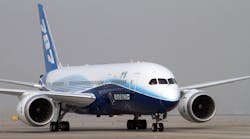BEIJING — China is expected to add more than 6,300 new aircraft to its commercial fleet by 2034, Boeing said Tuesday — an increase of more than 300 planes on its last forecast a year ago.
The world’s most populous country and second-largest economy will need 6,330 new aircraft worth $950 billion during the 2015-2034 period, Boeing said in its annual China Current Market Outlook. The country’s expanding economy and rising income are driving air travel growth, Boeing said, upping its prediction by 310 units from last year.
“We see strong growth in the country’s aviation sector over the long term,” Randy Tinseth, vice president of marketing at Boeing Commercial Airplanes, told reporters.
China’s economic growth is slowing as Chinese leaders try to reform the economy to let consumption, instead of government-driven investment, to play a bigger role. That growth model will be” more sustainable” and “bodes well for tourism,” Tinseth said.
China’s commercial fleet will number 7,210 aircraft by 2034, the firm said, nearly three times its current size, with aircraft going into service in the next two decades accounting for nearly 90% of it.
As China becomes the world’s largest domestic air travel market, Boeing predicts it will need 4,630 single-aisle planes over the period.
China’s increasingly affluent consumers and loosened visa policies for Chinese citizens will give long-distance international travel a boost, with 1,510 new widebody aircraft seen as needed.
Boeing said it made more than half the current Chinese commercial fleet, while Airbus says it has an almost 50% share. Tinseth said his company delivered 155 planes to China last year, 21% of its global shipments. It won orders for more than 400 aircraft in the country last year, he added, predicting 2015 will be “a great year.”
With the Chinese aviation market growing rapidly, Beijing has said it wants part of the multi-billion dollar market to go to its homegrown passenger planes.
State-backed Commercial Aircraft Corp. of China (COMAC) has started assembling the C919, a 158-168 seat narrow-body jet that would compete with Boeing’s 737 and the A320 of European consortium Airbus. It is also developing a wide-body passenger plane — tentatively called the C929 — in cooperation with Russia’s United Aircraft Corp.
“I think you have to take it seriously today,” Tinseth said. “The question with COMAC and some other manufacturers is when will they be successful rather than whether they’ll be successful.”
Boeing said in July that a projected 38,000 new aircraft from all manufacturers will be added to the global fleet over the next 20 years.
Copyright Agence France-Presse, 2015




